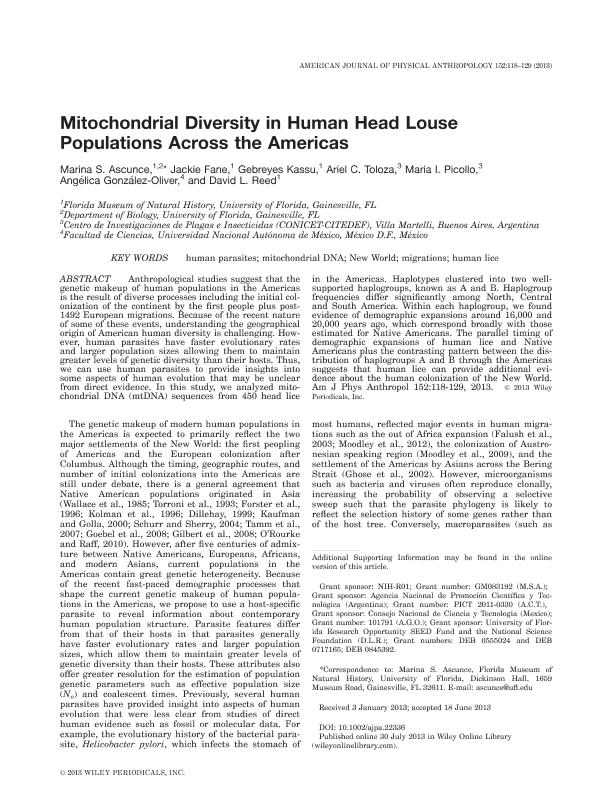Mostrar el registro sencillo del ítem
dc.contributor.author
Ascunce, Marina S.
dc.contributor.author
Fane, Jackie
dc.contributor.author
Kassu, Gebreyes
dc.contributor.author
Toloza, Ariel Ceferino

dc.contributor.author
Picollo, Maria Ines

dc.contributor.author
Gonzalez Oliver, Angélica
dc.contributor.author
Reed, David L.
dc.date.available
2016-09-06T20:55:00Z
dc.date.issued
2013-07
dc.identifier.citation
Ascunce, Marina S.; Fane, Jackie; Kassu, Gebreyes; Toloza, Ariel Ceferino; Picollo, Maria Ines; et al.; Mitochondrial Diversity in Human Head Louse Populations Across the Americas; Wiley; American Journal Of Physical Anthropology; 152; 7-2013; 118-129
dc.identifier.issn
0002-9483
dc.identifier.uri
http://hdl.handle.net/11336/7508
dc.description.abstract
Anthropological studies suggest that the genetic makeup of human populations in the Americas is the result of diverse processes including the initial colonization of the continent by the first people plus post-1492 European migrations. Because of the recent nature of some of these events, understanding the geographical origin of American human diversity is challenging. However, human parasites have faster evolutionary rates and larger population sizes allowing them to maintain greater levels of genetic diversity than their hosts. Thus, we can use human parasites to provide insights into some aspects of human evolution that may be unclear from direct evidence. In this study, we analyzed mitochondrial DNA (mtDNA) sequences from 450 head lice in the Americas. Haplotypes clustered into two well-supported haplogroups, known as A and B. Haplogroup frequencies differ significantly among North, Central and South America. Within each haplogroup, we found evidence of demographic expansions around 16,000 and 20,000 years ago, which correspond broadly with those estimated for Native Americans. The parallel timing of demographic expansions of human lice and Native Americans plus the contrasting pattern between the distribution of haplogroups A and B through the Americas suggests that human lice can provide additional evidence about the human colonization of the New World.
dc.format
application/pdf
dc.language.iso
eng
dc.publisher
Wiley

dc.rights
info:eu-repo/semantics/openAccess
dc.rights.uri
https://creativecommons.org/licenses/by-nc-sa/2.5/ar/
dc.subject
Human Parasites
dc.subject
Mitochondrial Dna
dc.subject
New World
dc.subject
Migrations
dc.subject
Human Lice
dc.subject.classification
Biología

dc.subject.classification
Ciencias Biológicas

dc.subject.classification
CIENCIAS NATURALES Y EXACTAS

dc.title
Mitochondrial Diversity in Human Head Louse Populations Across the Americas
dc.type
info:eu-repo/semantics/article
dc.type
info:ar-repo/semantics/artículo
dc.type
info:eu-repo/semantics/publishedVersion
dc.date.updated
2015-09-29T13:01:09Z
dc.journal.volume
152
dc.journal.pagination
118-129
dc.journal.pais
Estados Unidos

dc.journal.ciudad
Hoboken
dc.description.fil
Fil: Ascunce, Marina S.. University Of Florida. Florida Museum Of History. Departamento Of Biology; Estados Unidos;
dc.description.fil
Fil: Fane, Jackie. University Of Florida. Florida Museum Of History. Departamento Of Biology; Estados Unidos;
dc.description.fil
Fil: Kassu, Gebreyes. University Of Florida. Florida Museum Of History. Departamento Of Biology; Estados Unidos;
dc.description.fil
Fil: Toloza, Ariel Ceferino. Consejo Nacional de Investigaciones Científicas y Técnicas. Instituto de Investigaciones Científicas y Técnicas Para la Defensa. Centro de Investigación de Plagas E Insecticidas; Argentina
dc.description.fil
Fil: Picollo, Maria Ines. Consejo Nacional de Investigaciones Científicas y Técnicas. Instituto de Investigaciones Científicas y Técnicas Para la Defensa. Centro de Investigación de Plagas E Insecticidas; Argentina
dc.description.fil
Fil: Gonzalez Oliver, Angélica. FACULTAD DE CIENCIAS, UNIVERSIDAD NACIONAL AUTONOMA DE;
dc.description.fil
Fil: Reed, David L.. University Of Florida. Florida Museum Of History. Departamento Of Biology; Estados Unidos;
dc.journal.title
American Journal Of Physical Anthropology

dc.relation.alternativeid
info:eu-repo/semantics/altIdentifier/doi/http://dx.doi.org/10.1002/ajpa.22336
dc.relation.alternativeid
info:eu-repo/semantics/altIdentifier/url/http://onlinelibrary.wiley.com/doi/10.1002/ajpa.22336/abstract
Archivos asociados
